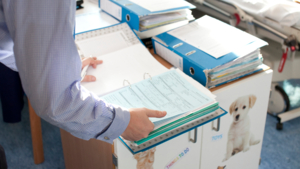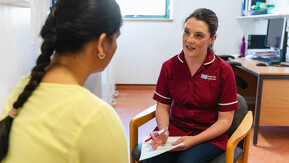
Overcoming barriers: equitable cancer care for the LGBTQIA+ community
In the second of this series, Dr Alison Berner discusses the barriers faced by the LGBTQIA+ community throughout the cancer pathway and what steps can be made to remove these barriers.
I remember when I booked my first smear test. I mentioned it to one of my friends from medical school.
“Do you even need one?” she asked. I’m bisexual and had been in a relationship with a woman for as long as she had known me. From her perspective, how could I possibly need one?
She had made an inaccurate assumption about my risk. This was based on longstanding myth that the sexual behaviour of women who sleep with women means they don’t get human papillomavirus (HPV), the virus responsible for 99% of cervical cancers. In fact, HPV can be transmitted, persist, and go on to cause cancer in ANYONE with a cervix.
But her mistake was not surprising because medical education on the health of LGBTQIA+ (lesbian, gay, bisexual, transgender, queer, intersex, asexual) people is lacking.
Research is improving but systems are slow to change. This is not helped by a lack of gender identity and sexual orientation monitoring in health, and a political climate that is hostile towards transgender people.
Inequalities persist throughout the cancer pathway, from screening through to end-of-life care. Here’s what we know and some of the work being done in the UK to address the gaps.
Screening
In the UK, invitations for national cervical and breast screenings are based on the gender a person is registered as. This creates a barrier to equitable screening as individuals registered as male will not be called.
Numerous studies have demonstrated lower uptake of breast and cervical screening among LGBTQIA+ populations.
One study found the most stark differences in cervical screening for trans men and non-binary people. Inequities are also compounded by intersectional identity, such as being ethnically diverse or being disabled.
Barriers to screening exist at a personal, organisational or policy level. Individuals may experience direct or anticipated discrimination, physical discomfort and/or dysphoria. The clinic environment may reinforce cisgender and heteronormative expectations, and there may be misinformation about risk and the need for screening.
In the UK, invitations for national screening for cervical and breast cancer remain based on the gender a person is registered as, not on the organs they have. This creates a systematic barrier to equitable screening as individuals registered as male will not be called. They can be screened on request but cannot access the same fail-safe mechanisms. More information about the current screening programmes in the UK are discussed in our screening for cancer blog.
Thankfully, work is ongoing to improve screening systems for transgender people at local and national levels, and studies are investigating the use of self-testing for HPV.
The Manchester-based Alternative Cervical Screening (ACES) LGBTQIA+ study explored the community’s knowledge, barriers to attending and the acceptability of self-sampling methods. Their nationwide survey revealed a lack of knowledge around HPV risk.
Urine sampling for HPV shed from the cervix is currently under study to see if it is an accurate method of cervical screening. This was the most popular choice for a future cervical screening method, especially within the transgender population.
Education campaigns, specific to the LGBTQIA+ community, around cervical screening and the introduction of the option of self-sampling methods for screening have real potential to decrease the current screening inequity.
The Self-TI study, launched in February 2024 is looking at HPV self-sampling from different parts of the body (mouth, vagina, anus and in urine) across trans men, trans women and non-binary people. This is because HPV can cause cancers in other parts of the body, including the mouth, throat, anus, and vagina.
Self-TI will determine how acceptable different methods are in practice, at home and in the clinic, and inform bigger studies on risk and screening in these populations.
Diagnosing and treatment
Research has shown that transgender patients had poorer survival rates and were less likely to receive treatment from some types of cancer.
The national Cancer Patient Experience Survey for England 2022 revealed inequalities for LGBTQIA+ patients living with and beyond cancer at a number of key stages during their treatment and care.
For example, lesbian and gay individuals were less likely to have been able to discuss needs or concerns before treatment started. Bisexual people were less likely to have been able to share worries or feel adequately supported while in hospital.
Transgender patients were less likely to receive the right amount of information before cancer surgery, or to receive adequate support between their final treatment and follow-up. This is no doubt due to the known shortage of education for oncology professionals on the intersection between cancer and gender affirming care.
Responding to this need, the UK Cancer and Transition Service (UCATS) is a virtual clinic offering advice to transgender and non-binary people with cancer, and their healthcare professionals, across the UK.
Taking a personalised approach, it integrates oncology and gender-affirming care and can also signpost to other services and patient support, such as OUTpatients, the UK’s LGBTQIA+ cancer charity. Any healthcare professional or patient can make a referral.
Quality of care is likely just one factor contributing to the poorer outcomes seen for some cancers among the transgender community. A US study showed that transgender patients had poorer survival from non-Hodgkin lymphoma, prostate and bladder cancers, and were less likely to receive treatment for kidney and pancreatic cancer. More research is needed to decipher the reasons behind this.
Body image and sexual wellbeing can be challenging for people after cancer treatment, and the needs for LGBTQIA+ patients may be different. For example, not desiring reconstructive surgery after a mastectomy for breast cancer. This compounds challenges faced by LGBTQIA+ people with cancers in organs that are highly gendered.
A study led by the University of Leicester explored experiences of uterine cancer care for this group. It identified specific care needs and considerations, particularly related to transvaginal procedures and survivorship.
The study’s participants felt that opportunities for disclosure of patients’ LGBTQIA+ identity during the uterine cancer care pathway were essential for these needs to be recognised. They identified a need for public health agendas and clinical services to address the needs of LGBTQIA+ uterine cancer patients.
Palliative and end of life care
LGBTQIA+ individuals approaching the end of their lives need special consideration, as ties with biological family can be strained due to stigma and there may be a greater reliance on chosen family.
Older members of the LGBTQIA+ community will have lived through a time where being gay was illegal and some can struggle to disclose their identity to healthcare staff. A report by Hospice UK found that transgender people in particular are likely to experience insensitivity from staff, and instances of poor physical care.
The Being Ready project is a collaboration between the Gender Identity Research and Education Society, Hospice UK, Stonewall and Marie Curie to improve trans and gender diverse experiences of dying, death and bereavement. Following a series of surveys and focus groups, they have now launched a nationwide training programme.
The way forward
Providing equitable cancer care to all patients requires cultural competency with education for all healthcare staff. It also necessitates dedicated research and specialised services locally and nationally. These should all be co-developed with community members, as in the examples discussed here.
If we can do this for all communities, including LGBTQIA+ people, we can build a health service that better serves us all.
About our information
You may also be interested in
Stories And Media
-
Blogs 04 Jun 2025A practical guide for healthcare professionals on understanding and supporting the diverse spiritual needs of cancer patients to enhance holistic, patient-centred care.
-
Blogs 25 Mar 2024In the final instalment of this series, Chief Nursing Officer Dr Claire Taylor MBE and Macmillan Lead Cancer Nurse Fungi Motsi, discuss the challenges and experiences for women in leadership in...








